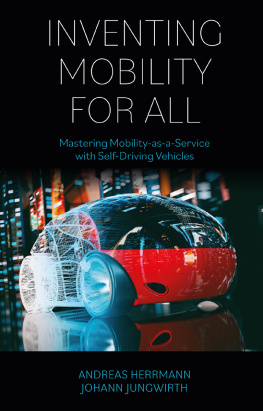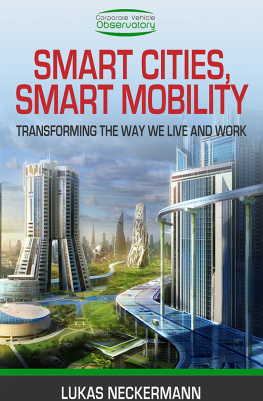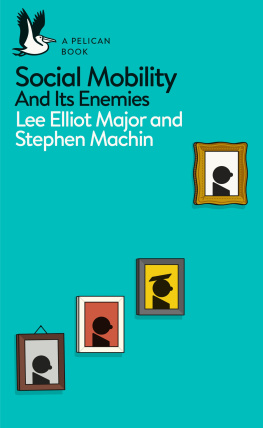Copyright 2022 Emerald Publishing Limited.
No part of this book may be reproduced, stored in a retrieval system, transmitted in any form or by any means electronic, mechanical, photocopying, recording or otherwise without either the prior written permission of the publisher or a licence permitting restricted copying issued in the UK by The Copyright Licensing Agency and in the USA by The Copyright Clearance Center. No responsibility is accepted for the accuracy of information contained in the text, illustrations or advertisements. The opinions expressed in these chapters are not necessarily those of the Author or the publisher.
FOREWORD
What drove us to write a book about Mobility-as-a-Service? First and foremost, we care about human-centric mobility solutions, which will determine this century. Sure, its also about technology and more precisely about electric, connected, and above all autonomous vehicles that you can summon with an app. It is about self-driving cars and buses controlled via a mobility platform. But its also about connecting all those cars, buses, trains, and the various forms of micro-mobility to create seamless transportation. Imagine driving with no steering wheel how fascinating is that?! Mobility in its new guise can lend a whole new shape to our lives, our daily routines, and of course our transportation choices. We can reinvent the very notion of travel.
Some of the finer points of the Mobility-as-a-Service concept still must be firmed up. Some aspects are still vague. We nevertheless felt it was important to embark on this tour dhorizon as few other accomplishments will likely transform our lives and the way we go places to the same extent as electric, connected, autonomous driving in conjunction with other modes of transportation. So, the time has come to address the concept of mobility at the push of a button, to foster public debate on the subject and to play our part in helping it change our lives for the better.
For us as the authors, engaging with this topic has been a moving experience in more ways than one, above all because discussions of vehicles, sensors, algorithms, and mobility platforms only scratch the surface of what this is really about. More fascinating still are the stories behind the new opportunities that Mobility-as-a-Service opens up for people. Especially in the megacities of this world, we can see for ourselves every day that mobility is one of the most important prerequisites for personal freedom and indeed personal development. If, through mobility on demand, we can succeed in transporting people faster, farther, and more easily, these people will gain access to better jobs and higher pay and have greater control over their lives. And think of people with impairments or disabilities, the elderly and the young who, in many countries and cities, are dependent on outside help to have any chance at all of a social life and participating in society. Consider the rural areas where the younger generation moves away, leaving the elderly behind, stores close, and even such essential services as a local general practitioner are no longer available. Providing inclusive Mobility-as-a-Service with autonomous vehicles for people, goods, and services could form at least part of the solution to these problems.
But there is even more at stake. At the UN Climate Change Conference in Paris in December 2015, 197 countries signed a new, global climate protection agreement that aims to limit global warming to 1.5 degrees Celsius compared to the pre-industrial era. To reach this goal means attaining carbon neutrality worldwide in the second half of this century; that is to say, not generating more emissions than can be sequestered by forests and other carbon reservoirs. It is imperative for the transportation sector to play its part in achieving carbon neutrality.
Just how important this is can be illustrated by any number of memorable and moving stories experiences, for example, of the people in many Asian and African cities who are at risk of suffocating in the exhaust fumes emitted by the soaring numbers of vehicles on the roads. Then there are the gigantic projects being undertaken in many metropolises to expand the transportation infrastructure in response to the spiralling mobility needs of their inhabitants. And when we factor in the millions of pedestrians, cyclists, drivers, and passengers killed or injured in road traffic accidents, there is no avoiding the truly decisive questions: Dont we finally need to organise our mobility better? Arent the social costs way too high? Can we still afford this kind of mobility, knowing full well that it could be done better? Therefore lets go. Lets embark on this journey. Lets get on the trail of Mobility-as-a-Service and see what this innovative concept has to offer.
Many faculty members, colleagues, experts, and leading figures from the fields of politics, business, and society have provided us with ideas and inspiration. We would like to thank them all for their readiness to share their knowledge and experience. Our discussions with Chris Urmson on autonomous and connected driving; with Anat Bonshtien on the new mobility industry in Israel; with Seung Won Kim on Daegu Smart City in South Korea; and with Cem zdemir on the challenges for government and society were particularly valuable. And a special vote of thanks goes to Niall Kennedy from Emerald Publishing for his support. Hes been a keen advocate of this project since the outset.
The outcome, we hope, is a book that sheds light on this subject from a variety of angles and that contributes to an open, honest, multilayered, and nuanced discussion of the opportunities of Mobility-as-a-Service. We, the authors are, we admit, euphoric and optimistic. We want change! We are convinced that electric, connected, and above all autonomous driving will change our lives, our environment, and our society for the better, in a world where mobility is no longer necessarily owned but used as a service. But of course, there are also doubts and concerns, and these too you will find reflected on the following pages.
Andreas Herrmann
Johann Jungwirth (JJ)
PREFACE I
Mobility is a topic that concerns all of us and is part and parcel of our everyday lives. We travel to work; visit family and friends; go to a doctors appointment; or take a trip to the local library, museum, or sports facility.
Mobility is a triumph of civilisation and at the very roots of urbanisation. The nature of our urban lives is shaped by the forms of mobility at our disposal. The identity of a city is inseparable from its iconic transportation system: Londons black cabs, the Tokyo Metro, the tuk-tuks in Bangkok and the three-wheelers in Mumbai, the freeways of Los Angeles and Dallas. According to Mark Twain, travel broadens the mind. Mobility also enables people to leverage their economic potential and empowers them to dream. But is the price of mobility not too high?











